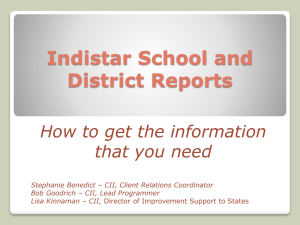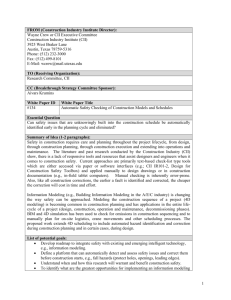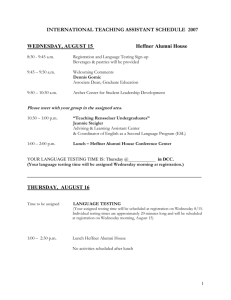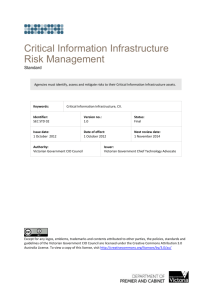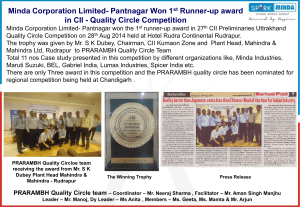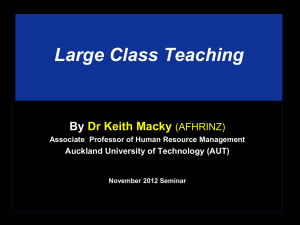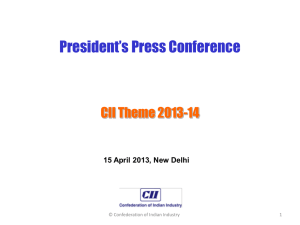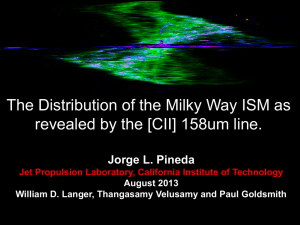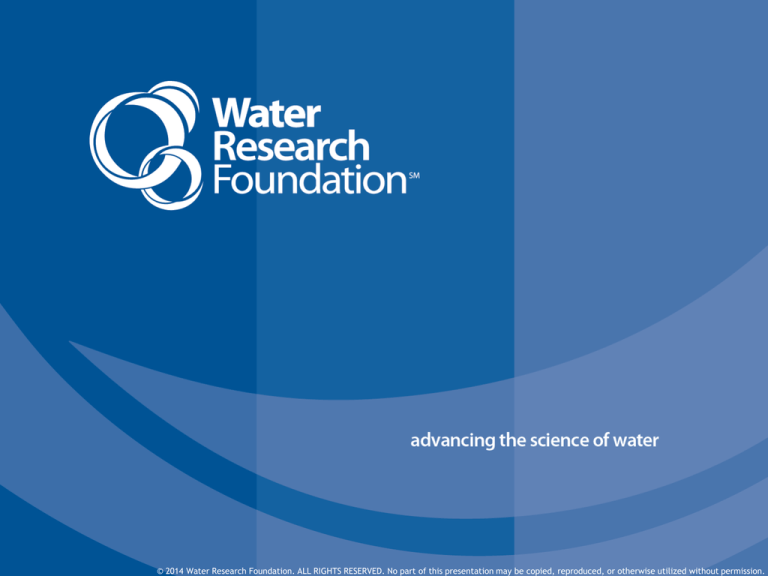
© 2014
Water Research
Foundation.
ALLwithout
RIGHTSpermission.
RESERVED.
© 2014 Water Research Foundation. ALL RIGHTS RESERVED. No part of this presentation may be copied,
reproduced,
or otherwise
utilized
Sustainable Water
Management Conference
Denver, Colorado
March 31, 2014
Presentation by Jack C. Kiefer, PhD and Lisa R. Krentz
© 2014 Water Research Foundation. ALL RIGHTS RESERVED.
Methodology for Determining Baseline
Commercial, Institutional, and
Industrial End Uses of Water
WRF Project #4375
Jack C. Kiefer, PhD
Lisa R. Krentz
© 2014 Water Research Foundation. ALL RIGHTS RESERVED.
Overview
• Project goals and objectives
• Background and examples about the research problem
• Elements of emerging methodology
© 2014 Water Research Foundation. ALL RIGHTS RESERVED.
WRF 4375: Goals
Methodology for Determining Baseline Commercial,
Institutional, and Industrial (CII) End Uses of Water
• Provide water utilities with better and consistent means of
understanding the amount of water used by their CII customers
by category and by end use or purpose
• This is methodological development—not direct measurement or
estimation of usage rates or end-use metrics or benchmarks!
© 2014 Water Research Foundation. ALL RIGHTS RESERVED.
WRF 4375: Objectives
• Establish data requirements and recommended
practices for:
1. Identifying practical or useful classifications of CII
users
2. Evaluating the range of end uses that are present
3. Calculating alternative metrics of water usage rates
© 2014 Water Research Foundation. ALL RIGHTS RESERVED.
Why are methodological improvements needed?
• CII consumption typically
30-50% of utility demands
• Easier targeting for water
efficiency programs
• Improve effectiveness of
water use forecasts
• Better usage rate metrics
for benchmarking
• Information for designing
rate structures
© 2014 Water Research Foundation. ALL RIGHTS RESERVED.
Basics of the “CII Problem”
• Heterogeneous sector
• Lack of consistent classification
• Significant variability in water use between and within classes of
customers
• Water use is a “derived demand” that is bundled into production
of goods and services
• “Explanatory” data generally lacking
© 2014 Water Research Foundation. ALL RIGHTS RESERVED.
Common and Less Common Classifications
Customary CII groupings
Single sector—
Nonresidential “catch-all”
Commercial and Industrial—
Linked to external
classifications
Land use/Building type
►
sometimes
49 premise codes
Institutional/Govt/Public
(majority
nonresidential)
Classification criteria not
always clear
City of Austin example —
Tied to wastewater charges
Phoenix AZ example —
previous system of 34
►
Florida Department of
Revenue — 57 CII
categories
NAICS or “NAICS-like”
classes (19 CII)
© 2014 Water Research Foundation. ALL RIGHTS RESERVED.
Heterogeneity and Variability
© 2014 Water Research Foundation. ALL RIGHTS RESERVED.
Within-Class Variability (Lodging example)
Luxury Hotels
Motels
© 2014 Water Research Foundation. ALL RIGHTS RESERVED.
Within-Class Variability (Office Building example)
Tower Type
© 2014 Water Research Foundation. ALL RIGHTS RESERVED.
Basics of the “CII Problem”
© 2014 Water Research Foundation. ALL RIGHTS RESERVED.
Basics of the “CII Problem”
© 2014 Water Research Foundation. ALL RIGHTS RESERVED.
Basics of the “CII Problem”
© 2014 Water Research Foundation. ALL RIGHTS RESERVED.
Basics of the “CII Problem”
© 2014 Water Research Foundation. ALL RIGHTS RESERVED.
Example Drivers of End Use Consumption
and Related Proxies
End Use Category
Demand Drivers
Cooling (water based)
Preferences/Policies
Irrigation
Irrigated Landscape Area
Sanitary
People (Visitors +
Employment)
Process water
Production Level
Proxies of Scale or Capacity
Tonnage
Cubic Footage
Irrigable Area
ET
Number of
Fixtures
Number of
Employees
Square
Footage
Square
Footage
Area
ET
Area
Number of
Employees
Square
Footage
Air
Temperature
Number of
Employees
Other/Misc
Pools Preferences/Policies
Food service
Volume of service (meals
served)
Single water use record not
broken into end uses
Air
Temperature
Seating
capacity
Multiple drivers or proxies of
scale
© 2014 Water Research Foundation. ALL RIGHTS RESERVED.
Differentiating Scale from Rate
(or Intensity) of Use
Q
Q N q N
N
Rate of use
Driver
For example:
• Water use in a school = avg. water use per student x students
• Water use in hotel = avg. water use per occupied room x
occupied rooms
• Water use for irrigation = avg. water use per irrigated sq. ft. x
irrigated area
© 2014 Water Research Foundation. ALL RIGHTS RESERVED.
Scale,
Intensity,Scale
andfrom
Sementti
Differentiating
Rate
Q
(or Intensity) of Use
Scatterplot of water use
and some measure of
scale for a set of
customers in a given CII
class
N
Rooms
© 2014 Water Research Foundation. ALL RIGHTS RESERVED.
Scale,
Intensity,Scale
andfrom Rate
Differentiating
(or Intensity) of Use
Segmentation
Q
Q = a + qN
General effects of scale
(e.g., water use
increases with
employment,
production, size of
facility)
N
© 2014 Water Research Foundation. ALL RIGHTS RESERVED.
Scale,
Intensity,Scale
andfrom Rate
Differentiating
(or Intensity) of Use
Segmentation
Q
q(no irrigation, no
cooling)
N
© 2014 Water Research Foundation. ALL RIGHTS RESERVED.
Scale,
Intensity,Scale
andfrom Rate
Differentiating
(or Intensity) of Use
Segmentation
Q
q(irrigation, no
cooling)
q(no irrigation, no
cooling)
N
© 2014 Water Research Foundation. ALL RIGHTS RESERVED.
Scale,
Intensity,Scale
andfrom Rate
Differentiating
(or Intensity) of Use
Segmentation
Q
q(irrigation, cooling)
q(irrigation, no
cooling)
q(no irrigation, no
cooling)
N
© 2014 Water Research Foundation. ALL RIGHTS RESERVED.
Basics of Emerging CII Methodology
• Classify customers along some common
definitions and criteria
— Vast majority of CII water use and accounts reside
in 20-25 categories
— End use dominant classes relatively easy to define
© 2014 Water Research Foundation. ALL RIGHTS RESERVED.
Example CII Classification Scheme
1.
2.
3.
4.
5.
6.
7.
8.
9.
10.
11.
Lodging
Office Building
School or College
Health Care Facility
Eating or Drinking Place
Retail Store
Warehouse
Auto/Auto Service
Religious Building
Retirement or Nursing Home
Manufacturing
12.
13.
14.
15.
16.
17.
18.
19.
20.
21.
22.
Other Commercial
Other Institutional
Other Industrial
Landscape only
Laundromat
Commercial or Industrial
Laundry
Car Wash
Park or Recreational Area
Golf Course
Power Plant/Utility
Server Facility/Data Center
© 2014 Water Research Foundation. ALL RIGHTS RESERVED.
Basics of Emerging CII Methodology
• Unless classification capabilities already exist, linkage
to external data is helpful for
— Defining NAICS-like categories
— Defining customer as a “water-using location”
— Assigning customers into classes
© 2014 Water Research Foundation. ALL RIGHTS RESERVED.
Basics of Emerging CII Methodology
• What do tax appraiser or parcel-level data provide?
— A useful measure of scale: square-footage
— Potential indicator for passive efficiency: year
built and year improved
— Lot size, footprint, stories, other
— Common spatial identifier to link to other data
sources
© 2014 Water Research Foundation. ALL RIGHTS RESERVED.
Basics of Emerging CII Methodology
• Primary data collection needed for further
market segmentation of CII customers (surveys
or audits)
• Data collection instrument developed to
— Establish fundamental “global” differentiators
▪ Irrigation?
▪ Cooling?
▪ Alternative supply source(s)?
— Dig deeper into operations
▪
▪
▪
▪
Business/property sub-classification
Presence of other end uses
Employment, visitation, production
Hours of operation, etc.
© 2014 Water Research Foundation. ALL RIGHTS RESERVED.
Info Management Methodology
Water Use Billing Data
External Business Data
Unique “Location”
• Tax Classification
•Square footage
Parcel Data
Unique “Location”
• Tax Classification
•NAICS Classification
•Square footage
•Employment
Aggregation by class to
support class
characterization,
forecasting, rate
design, etc.
Customer Surveys
Other External Sources
Unique “Location”
• Classification
•Square footage
•Employment
•Other drivers
•End Uses
•Operations
Samples by class to
support benchmarking,
program design, water
budget analysis, etc.
© 2014 Water Research Foundation. ALL RIGHTS RESERVED.
Distribution of Hotel Water Use Per Square Foot
(n=77)
0.6
Gallons per square foot per day
0.5
0.515
0.4
Mean = 0.244
0.3
0.293
0.2
0.201
0.146
0.1
0.083
0
5%
25%
50%
75%
95%
Percentile
© 2014 Water Research Foundation. ALL RIGHTS RESERVED.
Water Use per Room per Day (Annual Average 2006)
Hotel and Resort (n=4)
722
Other (n=3)
349
Condo or Time Share (n=1)
All/enhanced
amenities, high
occupancy
324
Motel (n=12)
158
Hotel (n=22)
151
Apartment Hotel/Motel (n=3)
Sample Mean = 215 gpd (n=45)
70
0
100
Irrigation,
pools, similar
amenities
200
No300irrigation,
400
no cooling, no
pools
500
600
700
800
© 2014 Water Research Foundation. ALL RIGHTS RESERVED.
Cautions
• Significant information management
work required
—Account geocoding
—Multiple meters serving a “location”
—Matching of accounts/meters to parcels
▪ 1 to 1 (good!)
▪ 1 to many/many to 1
▪ Many to many
© 2014 Water Research Foundation. ALL RIGHTS RESERVED.
Cautions
• Significant information management work
required (continued)
— Matching of business data
▪ Can cost $$
▪ Can have a mismatch between location and corporate
data
— Mixed use/multiple business locations
• Primary data collection involves sampling and
logistics
© 2014 Water Research Foundation. ALL RIGHTS RESERVED.
Next Steps
• Finish “beta-testing” of data collection instrument
• Refine and recommend final methodology
• Develop some illustrative examples
• Project report
© 2014 Water Research Foundation. ALL RIGHTS RESERVED.
Thanks!
• Utilities
— City of Austin
— East Bay Municipal Utility
District
— New York City Department
of Environmental Protection
— City of Boulder
— City of Fort Collins
— Colorado Springs Utilities
— Tampa Bay Water
— City of Phoenix
• Other Team Members
— Ben Dziegielewski
— University of Florida
— William (Bill)
Hoffmann
• Maureen Hodgins,
Water Research
Foundation
Jack C. Kiefer, PhD
jkiefer@hazenandsawyer.com
618.889.0498
© 2014 Water Research Foundation. ALL RIGHTS RESERVED.

